When I take my dog out on our local trails, I want him to walk on a loose leash, pay attention to me and not jump on people.
I just want my dog to behave in public.
Instead, Remy is a wild mess.
He’s just so excited! All of the time!
His eyes bug out. He makes no eye contact with me. He barely pays attention. He’s always pulling.
You see … my dog will listen fairly well at home. He’s even pretty good in our neighborhood. But once we drive to a trailhead or park or if someone comes to our door, Remy is so amped he can hardly focus.
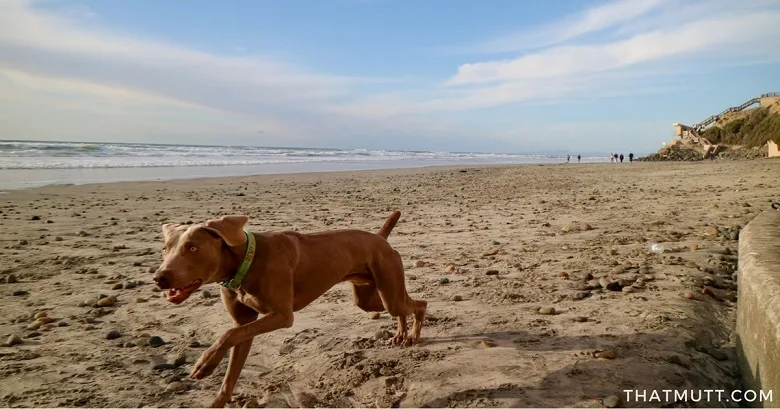
So this article focuses on training your excited or unruly dog to behave in public, specifically loose-leash walking and paying attention.
I’m writing a lot about stopping a dog’s pulling in this article, but you can use the same concepts with pretty much any issue. If you want your dog to come when called in public or to stop jumping on people you pass during walks, these tips should help.
I’d also like to hear what’s worked for you or ideas or questions you have. Leave them in the comments.
How to train your excited dog to behave in public
Overview of how to get your dog to behave in public:
Take a step back and …
- Define. What do you want your dog to do? Be specific.
- Goals. Write out 5 small training steps to work on. Start where your dog is already successful.
- Consistency. Dogs repeat what gets reinforced.
- Practice. Three 10-minute sessions per week or more.
- Hire a trainer or take a class. This gives a new perspective as well as distractions.
*Enjoying this article? Get realistic dog training tips emailed once a week. Click Here
How to have a calm dog in public – 12 tips
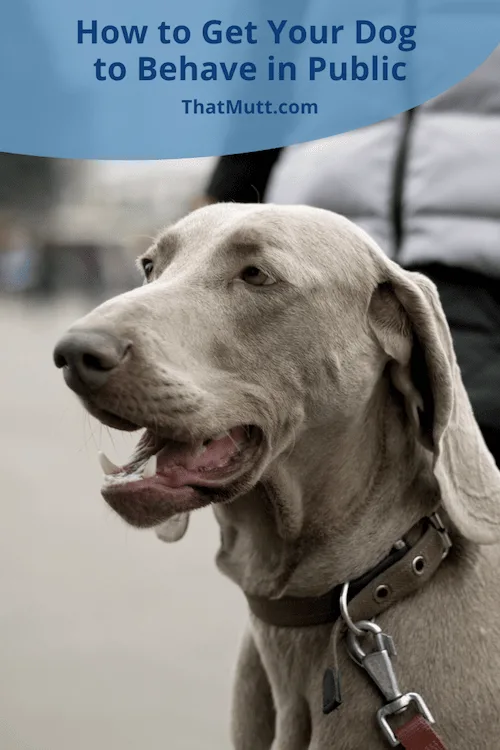
These are some ideas to consider as you work with your dog over the next few weeks and months. Training is ongoing.
First, a couple of basics:
- Exercise your dog before training sessions.
- Provide hard exercise every day for active dogs.
- If you have a puppy, begin socializing and visiting new places early.
Now onto my 12 tips for helping a dog to behave in public:
1. Don’t take your dog’s behavior personally.
Dogs are simple. They react to their environment. Their behavior is directly related to whatever has been reinforced throughout their lives.
Even if a dog’s behavior is “disrespectful” such as jumping on people or pulling on the leash, he’s not trying to be disrespectful. He’s just doing what he knows. So try not to get angry with your dog.
2. Don’t compare your dog to other dogs.
Believe me, I look at other dogs and I think, “Why can’t I get my dog to behave in public like that?”
Well, you never know what someone has gone through with their dog to get where they’re at. And, some dogs are just easier to train and don’t require as much work.
My previous dog Ace was usually the best behaved dog compared to others. My current dog Remy is usually the worst.
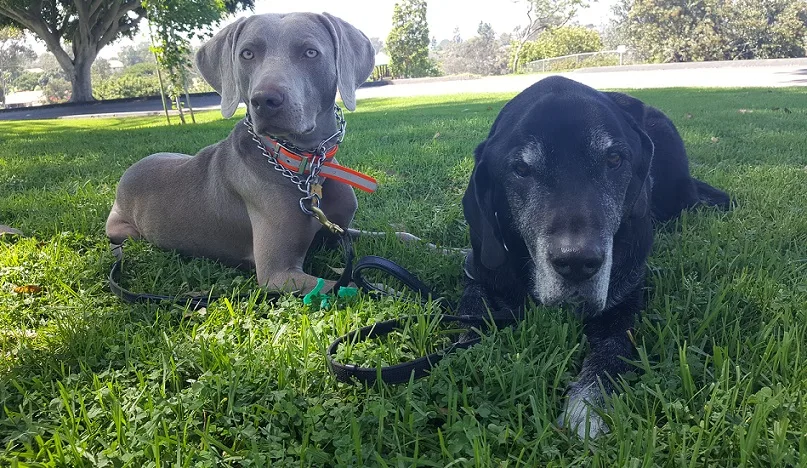
I didn’t work with Ace any more than I have worked with Remy. It’s just that their personalities and energy levels are so different.
I have to remind myself why I wanted a high-energy dog in the first place. I wanted a weimaraner for long-distance running. He’s great at it! But … there is a tradeoff. My dog is high energy, all of the time. All. Of. The. Time.
3. Define exactly what you want your dog to do in public.
Often, we know what we do not want our dogs to do, but we don’t define what we WANT them to do. So we fail to teach them.
A dog can’t understand what we want unless we consistently guide him. Often, we end up guiding our dogs to do the wrong thing by allowing or rewarding the wrong behaviors like jumping or pulling.
So, take a step back and really think about what, exactly, you want your dog to do. Then, we all have to make a point to head out and work on training.
Four examples of what you might expect from your dog in public
Four things I ideally want my dog to do in public: Walk on a loose leash, come when called, ignore other dogs on walks and polite greetings (no jumping).
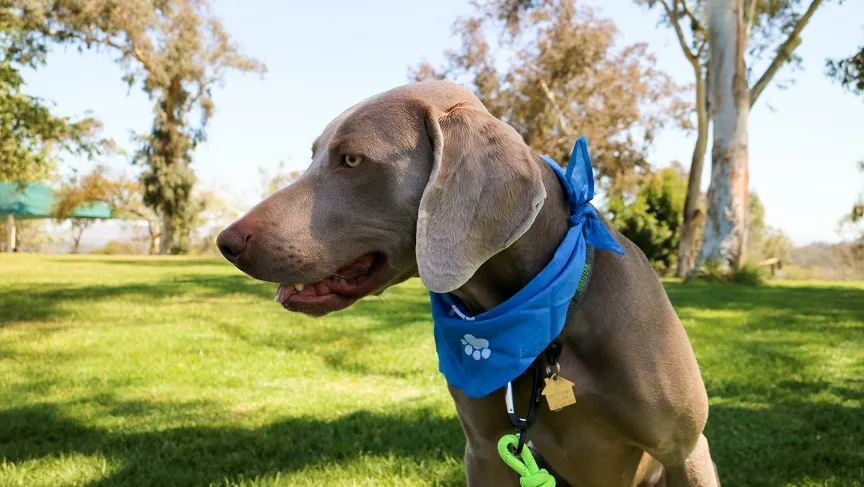
Walk on a loose leash
I want my dog to walk on a loose leash when the leash is attached to his collar. When the leash is attached to his harness, I personally do not care if he pulls. It’s a great workout for him!
Collar = loose leash.
Harness = pulling.
Come when called
I want my dog to drop everything and come and sit next to me when I say, “Remy, come!” no matter where we are.
Ignore other dogs during walks
I want my dog to ignore other dogs during walks and look to me instead. No pulling, barking or whining.
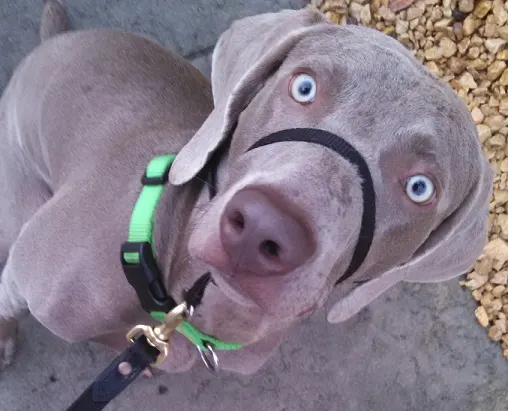
Polite greetings (no jumping)
I want my dog to greet people with permission as long as all 4 paws remain on the ground – no jumping.
So those are just four examples of what I want my dog to do in public. Your examples might be a bit different. For example, maybe you want your dog to lie down and stay at your feet while you visit a dog friendly brewery or outdoor restaurant.
Now, moving on to the rest of our training tips …
4. Break the training into small, reasonable steps.
From puppy potty training to loose leash walking, people almost always expect too much from their dogs too quickly. To get a dog to behave in public, we need to break their training into at least 4 tiny, manageable steps. And these steps will always overlap.
Seriously, if you just take a step back and really think about how you might train your dog, you have everything you need to do it yourself. I’m just here to encourage you to brainstorm and come up with your own plan.
For example, with teaching my dog not to pull on the leash, my “steps” will include the following. Treats and a training collar will be needed for all 5 steps:
Step 1: Work where we are already successful. For us, that means indoors. We’ll continue to practice loose-leash walking indoors, because Remy is already successful there. I can reward him with treats and praise for his good work. Good boy!
Step 2: Work in slightly more challenging areas, and I mean slightly. This could be right outside our front door, in our own yard or around our own neighborhood. We will also continue to work on Step 1.
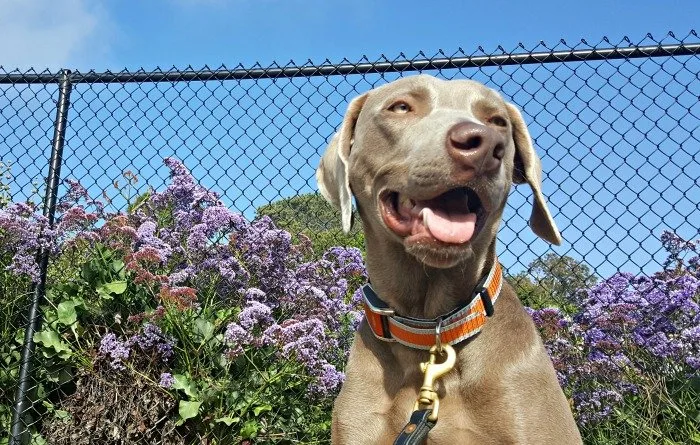
Most of us make the mistake of not taking our dogs out in public enough, and then when we do, we expect too much from them in new and exciting environments. So, practice more often where your dog can be successful!
Step 3: Drive somewhere more “exciting” but not too distracting such as a church parking lot or a very quiet park. Remy will practice getting out of the car calmly, waiting for my “break” command.
Then he will sit and give me eye contact for a treat. Only then will we perhaps walk for 5-10 mins in small circles or zig-zags near our car. Then we go home. We continue to work on steps 1 & 2 as well.
Step 4: Maybe now we can try actually walking on a trail or at a park a bit, avoiding a straight line but including some circles, U-turns and zig-zags. I will reward Remy for making eye contact. Session lasts only 10-15 mins. Then we go home. We continue to work on all previous steps.
Step 5: Try going for an actual short walk on a trail or at a park in a straight path, which is the hardest for my dog. I will be prepared to switch directions as needed to re-gain his focus or to walk in random circles around rocks or benches. Training still needs to be short, just 10 mins or so.
These steps are specific to Remy and I based on what he needs in order to be successful. You know your dog best and your steps would look totally different than ours.
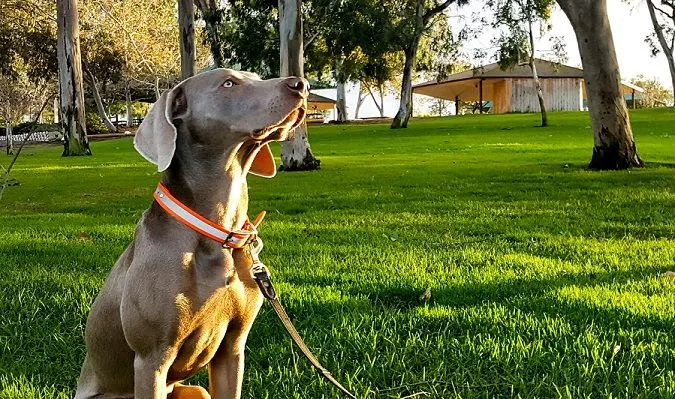
For example, if you want your dog to sit calmly at an outdoor restaurant, you would focus your training on working on down/stay and sit/stay in different environments. Start with a quiet park. Then maybe a slightly busier area. Then maybe you practice in a Petco or Home Depot.
I’ve recently started using a clicker more often for training, and Remy responds really well to it. It even works for heeling.
I’m normally not much of a clicker trainer because it gets a bit cumbersome, but clicker training really helps Remy understand exactly what I’m looking for. Try using a clicker for your own pup and let me know if it helps!
5. Practice with your dog at least 3 times per week.
You might think that three 10-minute sessions per week is not enough. If you can do every day or twice a day, even better.
I say three 10-minute sessions a week because that is something everyone can do.
Personally, I try to train my dog for 10 minutes every day during my lunch break. I also plan a short, 15-minute training session on Fridays where I drive my dog somewhere “new” to practice.
I highly recommend you seek out “new” and “exciting” areas to practice, but start small. If we never take our dogs out anywhere to work on training, it’s not fair to expect them to magically behave when we do take them out.
6. Practice basic obedience in new areas to get him to behave in public.
Once your dog has mastered the basics such as sit, down and stay with minimal distractions at home, make a point to practice in more challenging areas.
Yes, I keep repeating this because it’s so important. Slowly build up to more and more challenging environments no matter what you’re working on.
Start out in your front and back yard or in your driveway. Then try working in your immediate neighborhood. As your dog is successful, make a point to train in slightly more challenging areas such as a quiet church parking lot or a quiet park on a weekday morning.
If your dog is struggling, just go back to practicing where he was successful. Use highly valued treats such as Wellness treats or real meat.
I also find it helps my own dog if I use a clicker for training and mark the exact moment he does the correct behavior.
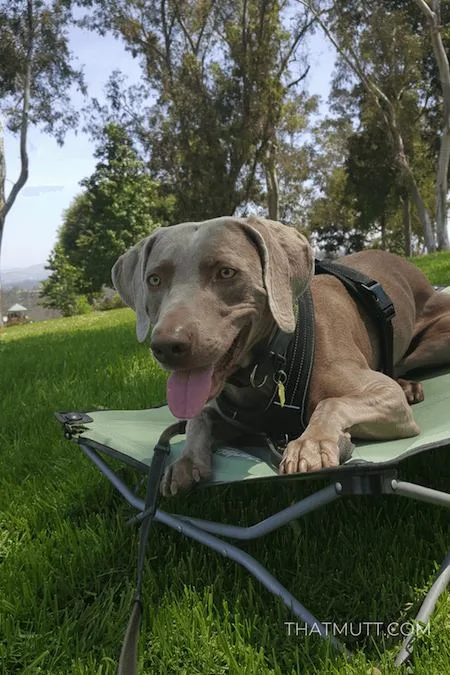
In addition to basic obedience commands, make a point to work on your dog’s overall impulse control at home and in new areas. The reason these high-energy dogs have a hard time focusing in public is often due to a lack of impulse control (Remy is this way, for sure).
7. Reward your dog for making eye contact.
This one is HUGE. It’s so important, and I’ve been overlooking it for years!
You see, my crazy dog has a hard time paying attention to me in “exciting” areas because … well, he probably thinks I’m boring!
If you want your dog to behave in public, really work on getting him to pay attention to you.
Here’s a very helpful tip: Grab a Ziploc or treat pouch full of small treats and your clicker and go sit at a quiet park or other public area with your dog. Tie his leash to the bench or hold the end, but let him have slack.
Just sit there and do nothing. Every time your dog makes eye contact with you, click and give a treat.
This is teaching your dog to pay attention and check in with you on his own, with no cue.
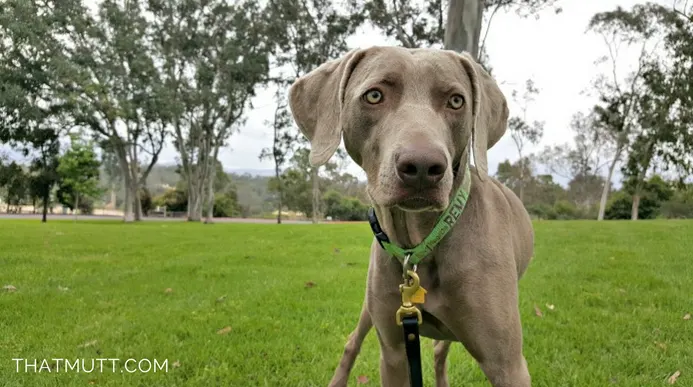
You might be lucky and have a dog who sits there staring at you the whole time, obsessed with either you or the treats! That’s great! You have a dog who is super focused!
This means you can move on to more challenging areas to practice this exercise. Maybe you move on to a place where there are a lot of squirrels, ducks or people passing. Maybe you can even try walking through the Home Depot or Petco.
On the other hand … your dog might be like mine and a whole minute or two could go by where he doesn’t look at you once! (YIKES). Don’t worry. Reward even if he ever so slightly glances at you for a split second.
Then, go back and practice this exercise at home or in your own yard where it’s less distracting.
Build on your dog’s success.
8. Think of the training from your dog’s point of view.
For example, my dog has always been allowed to pull me on trails. This is because I’ve never taken the time to enforce loose-leash walking when we go to trails. I’m there to run or hike, so that’s what we do.
Meanwhile my dog is pulling ahead the entire time. Like, he never stops pulling.
My dog does not know anything other than pulling when we’re on the trails, so that’s what he does.
Think about your own dog and the behaviors you’ve been “rewarding” all these years. It’s never too late to make some changes.
9. Find the ideal training collar or harness for your unique dog. Keep an open mind.
There is no “bad” training collar, and sometimes you have to learn to tune out other people’s opinions. Use what works to set your unique dog up for success. You know your own dog best!
I recommend you try a couple of different options such as a:
Even if you have a trainer who says “absolutely no chain collars” (common these days), I encourage you to try a prong collar if you’re struggling with your current setup. If you have any questions about using any of these tools, email me at Lindsay@ThatMutt.com
For my dog Remy, I use either a Gentle Leader that fits over his mouth area or a prong collar. I don’t give him corrections with the prong collar, and just so everyone knows, the ends of the prongs are flat.
Both tools make pulling slightly uncomfortable for the dog – pressure on the nose with the Gentle Leader or pressure on the neck with the prong collar. When my dog is at my side, he gets treats and praise. Simple as that.
Here’s a link to my longer writeup on the differences between a Gentle Leader and a prong collar.
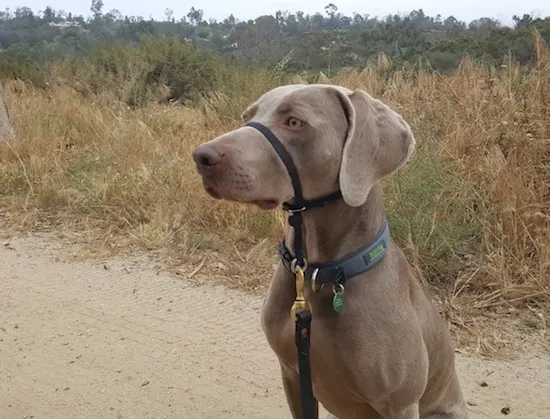
I personally do not recommend a simple “choke chain” collar too often because that type of collar has been the least effective for me with large, powerful dogs. But if a simple choke chain or martingale collar works for your dog, then by all means, use it!
Also, I think it goes without saying, but you want to use a 6-ft leash, not a retractable leash while you work on training. For working on distance, I recommend a long leash or check cord.
10. Sign up for an obedience class or hire a dog trainer.
A group obedience class is really helpful even if you know a lot about dog training. You might even know more than the actual instructor, and that’s OK.
In a class setting, you can practice with your dog around the distractions of other dogs and people and being in a new environment. I found a group class for Remy and I that starts in January.
Likewise, if you hire a one-on-one dog trainer, she can offer suggestions you may not have considered. It’s helpful to have a knowledgeable person observe you and your dog and point out what you might do better.
I recently thought about hiring a trainer to come to my house and help me with Remy. I’ll report back on how it goes if we decide to hire her, but I can only imagine she will help us meet our goals faster.
Think of your dog trainer as a “coach” to offer tips and hold you accountable.
11. It’s never too late to start training your dog to behave in public.
My dog is 4.5 years old. We train every day in some way. I know he has a lot of potential and we’re not even close to reaching that yet. I will keep training Remy his whole life. He might be a pretty well-behaved guy by the time he’s 7 or 8!
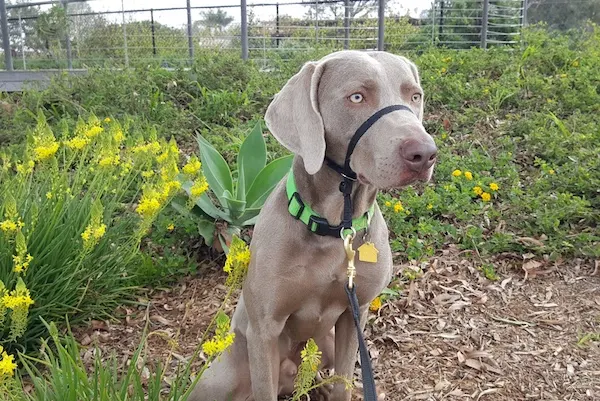
If you just adopted an 8-year-old dog or even if you’ve had him since he was a puppy, you can still make positive changes.
That being said, if you have a puppy, now is a great time to get started taking them to lots of new places early on.
See my socialization tips for puppies.
12. Join the conversation on That Mutt.
Here at That Mutt, we are a community of active dog lovers! We train and exercise our dogs nearly every day. This website is a great place to post your questions, progress or suggestions for others.
You can also leave a comment below and let me know what you’re working on or what questions you have.
I hope this article has helped you realize you are more than capable of training your own dog and making positive changes. It usually just comes down to actually setting aside time to think things through and coming up with a consistent plan!
-Lindsay & Remy
*Enjoying this article? Get realistic dog training tips emailed once a week. Click Here
FAVORITE TRAINING TOOLS:
- Wellness treats.
Wellness Well Bites are treats almost all dogs are willing to work for and focus on! - Treat bag.
Carry your treats in a convenient treat pouch around your waist so you’re always ready to reward your dog for heeling, coming when called or paying attention to you. - Gentle Leader.
A Gentle Leader helps a lot of dogs learn not to pull on the leash. - The Farmer’s Dog.
My dogs eat fresh food delivered to our door from The Farmer’s Dog. Get 50% off your first order.
Related training articles:
- How to stop my dog’s pulling
- Exercise tips for hyper dogs
- How to get my dog to be calm around visitors
- Get my dog to come when called
- Dog socialization tips
- Why is my dog so bad?
Lindsay Stordahl is the founder of That Mutt. She writes about dog training, dog exercise and feeding a healthy raw diet.

Karen Tolan
Thursday 28th of April 2022
My small puppy is afraid of the car. She trembled whenever we get in it and will come no where near it just walking thru the yard. She is somewhat better if in her kennel. I wanted to be able to take her places but don’t like seeing her traumatized. Any ideas how to get beyond this. Thanks!
Lindsay Stordahl
Friday 29th of April 2022
Here is my article on that topic: https://www.thatmutt.com/2014/07/21/help-a-dog-that-doesnt-like-riding-in-the-car/
Peggy berry
Wednesday 16th of June 2021
I have a Belgian Tuvern Shepard. He so anxious it’s just crazy. If I take him with me he whines or barks right in my ear. If I leave him home in the bedroom he laps my bedspread until it’s soaked. He’s barking when I leave and barking when I come home. So anxious when I leave him home alone and when I take him with me. I’m at a loss. Yes he’s with me usually 24/7. I’m retired and disabled. So it’s always been just us. Help.
Lindsay Stordahl
Thursday 17th of June 2021
Oh gosh, that sounds so stressful for everyone. I would talk to a behaviorist/trainer about what is best to do, someone who can meet you in person. I would also discuss anti anxiety medication with his vet.
Some things I would do now to help him would be to take him on a couple of long walks (45 to 60 mins) in nature each week where he is on a long leash with a harness and just let him sniff and run and be a dog. The woods or a field would be great or trails or even a soccer field when not in use. I would also feed him all of his meals in either Kongs or other puzzle-type toys to give him something to work on mentally.
It will take a long time to work through this level of anxiety but those are some things I would start with.
Susan Thompson
Monday 23rd of November 2020
Great article, Lindsey! I have a 2 year old "mini" golden retriever, Emmy. She is very excitable and has been much more challenging than my old girl, Chloe. I need to remember to be patient, baby steps, and especially consistent! Sometimes it's easy to give up and just let the unacceptable behavior take over. Her energy is awesome for our agility training, but not so much on a walk through the neighborhood! Hope you are well!
Lindsay Stordahl
Monday 23rd of November 2020
Hi Susan! Yes, I think that's what we all need to remember - baby steps an be consistent and patient.
Nancy Stordahl
Thursday 19th of November 2020
Sometimes I think we avoid taking our dogs out in public because we think everyone is going to notice our less than well-behaved dog and think "bad things" about us. Truth is, other people probably don't notice half the things we notice about our dog's poor (or good) behavior. So, we probably should stop being so self-conscious and just get out there. Easier said than done!
I have found the Gentle Leader to be one of the most useful training tools, though I know they don't work for all dogs. Thanks for the excellent tips.
Lindsay Stordahl
Thursday 19th of November 2020
Yep, most people won't notice or care what my dog does!
Carol North
Thursday 19th of November 2020
Great information here! I've used a few of your suggestions from this and other of your articles in working with Murphy, and he is learning. Thank you!
Lindsay Stordahl
Thursday 19th of November 2020
Thank you!